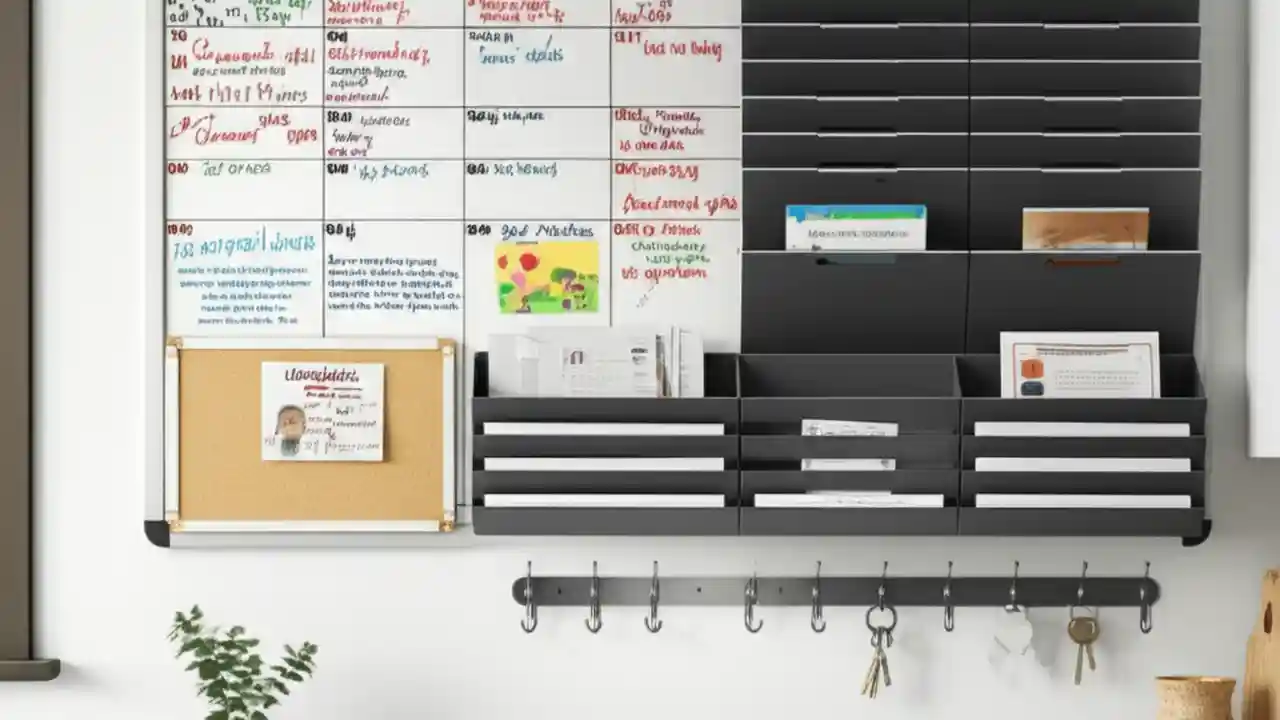Setting healthy boundaries is the essential practice of clearly communicating your personal needs, limits, and expectations to others. It’s about taking ownership of your well-being by consciously deciding what you will and will not accept in your interactions, protecting your time, energy, and mental health in the process.
For many of us, the idea of setting boundaries can feel selfish or confrontational. But after two decades of guiding people through this process, I can tell you it’s the exact opposite. It is one of the most profound acts of self-respect and a cornerstone of any healthy relationship, whether at work or at home. This guide will walk you through exactly how to set healthy boundaries, providing clear examples and scripts you can use today.
We’ll explore what boundaries actually are, why they are so critical, and a step-by-step method for implementing them. We will also tackle the tough parts, like how to say no without feeling guilty and what to do when people push back. This is your definitive roadmap to a more balanced and empowered life.
Table of Contents
Understanding the Fundamentals of Healthy Boundaries
Before we can set boundaries, we need to be crystal clear on what they are and why they matter so much. Think of them not as walls to keep people out, but as fences with gates. You decide who comes in, how far they come in, and when they need to leave. It’s about creating a safe space for yourself.
What exactly are healthy boundaries?
Healthy boundaries are the limits and rules we set for ourselves within relationships. They are guidelines, not ultimatums, that help you define what is reasonable, safe, and permissible for you. They also help others understand how to best interact with you.
A lack of boundaries often shows up as feeling resentful, overwhelmed, or taken advantage of. You might find yourself saying “yes” when you mean “no,” or feeling drained after interacting with certain people. Healthy boundaries are the antidote to these feelings.
Why are boundaries so crucial for your mental and emotional well-being?
Boundaries are fundamental to your health for several key reasons. They protect you from burnout by conserving your emotional and mental energy. They increase self-esteem and self-respect because you are actively prioritizing your own needs. They also foster healthier, more respectful relationships by creating clarity and reducing misunderstandings and resentment.
Ultimately, boundaries give you agency over your life. They are a declaration that your needs matter, which is a powerful message to send to yourself and to the world.
What are the different types of boundaries?
Boundaries aren’t just one-size-fits-all. They exist across different areas of our lives. Understanding the types can help you identify where you might need to strengthen yours.
| Boundary Type | Description | Example |
|---|---|---|
| Physical Boundaries | Your personal space, privacy, and body. This includes who can touch you, how close they can stand, and your need for solitude. | “I’m not much of a hugger, but I’d love to shake your hand.” |
| Emotional Boundaries | Separating your feelings from others’. It’s about not taking responsibility for their emotions or letting theirs dictate yours. | “I can listen to your frustration, but I can’t take on the responsibility for fixing the situation for you.” |
| Time Boundaries | Protecting how you spend your time. This involves limiting how much time you give to work, social events, or certain people. | “I can’t stay late tonight, but I can look at this first thing in the morning.” |
| Intellectual Boundaries | Respecting different ideas and opinions. It means you can have a conversation without being dismissive or belittled for your thoughts. | “We clearly have different views on this, and that’s okay. Let’s agree to disagree.” |
| Material Boundaries | Setting limits on your possessions. This involves what you’re willing to lend and how you expect your things to be treated. | “You can borrow my car, but please make sure to refill the gas tank before you return it.” |
| Digital Boundaries | Rules for how people interact with you online. This includes response times for emails/texts and what is shared on social media. | “I turn off my work notifications after 6 PM to be present with my family.” |
What are some clear examples of unhealthy boundaries?
Recognizing unhealthy boundaries, or a lack thereof, is the first step. Here are some common red flags:
- Feeling guilty for saying “no.”
- Over-sharing personal information with people you just met.
- Allowing others to make decisions for you.
- Feeling exhausted or resentful after talking to a specific person.
- Ignoring your own needs to please others (people-pleasing).
- Taking on the emotional baggage of everyone around you.
- Making excuses for other people’s poor behavior toward you.
If any of these sound familiar, it’s a clear sign that it’s time to start building healthier boundaries.
Your Step-by-Step Guide to Setting Boundaries
Setting boundaries is a skill, and like any skill, it gets easier with practice. It doesn’t have to be a big, dramatic confrontation. Often, the most effective boundaries are set calmly and simply. Here’s a practical, four-step approach.
How do I start setting boundaries if I’m a people-pleaser?
If you’ve spent a lifetime putting others first, this will feel unnatural at first. That’s okay. The key is to start small and be consistent. Follow this simple framework:
- Identify Your Limits: Pay attention to your feelings. When do you feel resentment, anger, or burnout? These feelings are signals. What specific interaction caused it? That’s where a boundary is needed. For example: “I feel resentful when my friend calls me during work hours to vent for an hour.”
- Communicate Clearly and Simply: You don’t need a long explanation. A simple, firm, and kind statement is best. Use “I” statements to focus on your needs, not their behavior. Example: “I want to be there for you, but I can’t take personal calls during my workday. Can we talk after 5 PM?”
- Uphold the Consequence (Gently): A boundary is only real if you maintain it. If the person crosses it again, you must gently enforce it. Example: If the friend calls during work again, you say, “Hey, like I mentioned, I can’t talk right now, but I’ll call you back at 5.” Then, you end the call.
- Practice and Repeat: It will feel awkward. You might feel guilty. Do it anyway. Each time you set and hold a boundary, you are strengthening that muscle and teaching others how you expect to be treated.
What are some simple, effective scripts for setting boundaries?
Having a few phrases ready can make all the difference. It removes the panic of trying to find the right words in the moment. Here are some scripts for common situations.
| Situation | Boundary-Setting Script |
|---|---|
| Being asked to do something you don’t have time for. | “Thank you for thinking of me, but I don’t have the capacity to take that on right now.” |
| Receiving unsolicited advice. | “I appreciate you trying to help, but I’d like to figure this out on my own.” |
| Someone is being emotionally draining. | “I have the emotional space to listen for about 10 more minutes.” |
| A family member making critical comments about your life choices. | “I know you mean well, but my [career/parenting/relationship] is not up for discussion.” |
| A friend pressuring you to go out when you need rest. | “I’d love to see you, but I need a quiet night in to recharge. Can we reschedule for next week?” |
| A colleague asking you to work on something after hours. | “I’ll be able to get to this first thing in the morning when I’m back online.” |
How do I say ‘no’ politely but firmly (and without the guilt)?
The word “no” is a complete sentence. However, many of us feel the need to justify it. You don’t have to. The key to saying no without guilt is to remember that you are not rejecting the person; you are declining a request to protect your own well-being.
Try these techniques:
- The Direct “No”: “No, I won’t be able to do that.” (Polite, firm, and requires no explanation).
- The “Let Me Think About It” No: “Let me check my schedule and get back to you.” This gives you time to formulate your ‘no’ without pressure.
- The “Policy” No: “I have a personal policy of not lending money to friends, but I’m happy to help you brainstorm other options.”
- The Empathetic No: “I know this is really important to you, and I’m sorry I can’t help at this time.”
Navigating Common Challenges and Pushback
When you start setting boundaries, not everyone will celebrate. Some people, especially those who benefited from your lack of boundaries, may resist. This is normal. How you handle it is what matters.
What should I do when someone reacts negatively to my boundaries?
Expect some pushback. It can come in the form of anger, guilt-tripping (“I thought we were friends!”), or ignoring the boundary completely. Don’t be alarmed; this is the “boundary test.” They are checking to see if you are serious.
Your job is to remain calm and consistent. Do not get drawn into an argument. Do not over-explain or justify your boundary. Simply restate it. For example, if they get angry, you can say, “I understand you’re upset, but this is what I need.” If they persist, you may need to create more distance by ending the conversation or leaving the situation.
How can I manage the guilt that comes with setting boundaries?
Guilt is often the biggest hurdle, especially for kind, empathetic people. It’s crucial to reframe this feeling. The guilt you feel is not evidence that you’ve done something wrong. It’s often a sign that you’re breaking an old, unhealthy pattern. It’s a symptom of growth.
When guilt arises, remind yourself of *why* you set the boundary. Was it to protect your mental health? To have more time for your kids? To avoid burnout? Connect back to your core reason. Over time, as you see the positive results of your boundaries, the guilt will fade and be replaced by a sense of peace and self-respect.
How do I know if my boundaries are too rigid or too loose?
Boundaries should be flexible, not rigid walls. The goal is connection, not isolation. Here’s a quick check:
- Too Loose (Porous): You often feel taken advantage of, over-share, get overly involved in others’ problems, and have trouble saying no. You feel resentful and depleted.
- Too Rigid: You avoid intimacy and close relationships, keep others at a distance, have a hard time asking for help, and seem detached or unapproachable. You might feel lonely.
- Healthy: You value your own opinion, don’t compromise your values for others, share appropriately, and are accepting when others say “no” to you. You feel balanced and respected.
Applying Boundaries in Real-Life Scenarios
Theory is great, but let’s talk about how this works in the real world. Here are some common high-stakes areas where boundaries are essential.
How can I set effective boundaries with difficult family members?
Family dynamics are often the most challenging. You can’t choose your family, but you can choose how you interact with them. Start by accepting that you cannot change them; you can only change your response.
For a parent who gives unsolicited advice, you might say, “Mom, I love you and I know you want to help, but I need to make my own decisions about my career. I’m not going to discuss it further.” Then, change the subject. If they bring it up again, end the conversation politely: “I have to go now, let’s talk again soon.” The key is calm, loving repetition.
What are the key boundaries to set at work to prevent burnout?
The “always-on” work culture has made professional boundaries more important than ever. Here are some non-negotiables:
- Time: Define your working hours and stick to them. Don’t answer emails or messages late at night or on weekends unless it is a true, pre-defined emergency.
- Workload: Learn to say no to new projects when your plate is full. You can say, “I’d love to help, but my priority right now is X and Y. I can either tackle this new task and de-prioritize one of the others, or perhaps someone else has the capacity.”
- Meetings: Decline meetings that don’t have a clear agenda or that you don’t need to be in. Protect your focus time.
How do boundaries work in romantic relationships and friendships?
Healthy boundaries are the bedrock of intimacy and trust. In a relationship, this means respecting each other’s need for personal time and space. It means not expecting your partner or friend to be your sole source of happiness. It also involves emotional boundaries: being able to share your feelings without blaming, and listening to their feelings without trying to “fix” them.
A great boundary in a friendship could be, “I love our chats, but I’m not a great texter during the day. If it’s urgent, call me, otherwise I’ll get back to you in the evening.” This manages expectations and prevents misunderstanding.
Conclusion
Learning how to set healthy boundaries is not a one-time fix but a lifelong practice of self-awareness and self-respect. It’s about trading short-term discomfort for long-term peace. By clearly and kindly communicating your limits, you are not pushing people away; you are teaching them how to love and respect you better, creating the space for more authentic and sustainable relationships to flourish. It is one of the most powerful gifts you can give yourself.
If this guide has been helpful, please consider sharing it. You never know who in your life might be silently struggling and in need of this permission to put themselves first.







